Submitted:
11 April 2024
Posted:
12 April 2024
You are already at the latest version
Abstract
Keywords:
1. Introduction
2. Materials and Methods
2.1. Study Area
2.2. Data and Preprocessing
- Tree cover: This class includes any geographic area dominated by trees with a cover of 10% or more.
- Shrubland: This class includes any geographic area dominated by natural shrubs having a cover of 10% or more.
- Grassland: This class includes any geographic area dominated by natural herbaceous plants (Plants without persistent stems or shoots above ground and lacking definite firm structure): (grasslands, prairies, steppes, savannahs, pastures) with a cover of 10% or more.
- Cropland: Land covered with annual cropland that is sowed/planted and harvestable at least once within the 12 months after the sowing/planting date.
- Built-up: Land covered by buildings, roads, and other man-made structures such as railroads. Buildings include both residential and industrial buildings. Urban green (parks, sports facilities) is not included in this class. Waste dump deposits and extraction sites are considered bare.
- Bare/sparse vegetation: Land with exposed soil, sand, or rocks and never has more than 10 % vegetated cover during any time of the year.
- Permanent water bodies: This class includes any geographic area covered for most of the year (more than 9 months) by water bodies: lakes, reservoirs, and rivers. Can be either fresh or salt-water bodies. In some cases, the water can be frozen for part of the year (less than 9 months).
- Herbaceous wetland: Land dominated by natural herbaceous vegetation (cover of 10% or more) that is permanently or regularly flooded by fresh, brackish, or salt water.
2.2.1. TROPOMI Product
2.2.2. Anthropic indicators
2.2.3. Climatic Indicators
- Palmer Drought Index: The index uses precipitation and environment temperature data to study moisture supply and demand using a simple water balance model. Negative values indicate droughts and positive values indicate wet areas.
- Vapor pressure (kPa)
- Max and Min environment temperature (°C)
- Wind speed (m/s)
2.2.4. Natural indicators
- NDVI (normalized vegetation index.): NDVI is based on the reflectance of the NIR wave in healthy plants and on the reflectance of the red wave to detect less healthy plants. This index is defined by values ranging from -1 to 1.
- Tasseled Cap:
- Brightness: low brightness values in coincidence with forested areas or, in general, with vegetation cover or bodies of water;
- 2.
- Greenness: it is related to plant masses and bodies of water;
- 3.
- Humidity: related mainly to bodies of water, but also the moisture content of vegetation and soils;
- 4.
- DEM: This SRTM V3 product (SRTM Plus) is provided by NASA JPL at a resolution of 1 arc-second (approximately 30 m).
2.3. Statistical Analysis
3. Results and Discussion
3.1. Spatiotemporal Distribution of CO and NO2 in Argentina during the Years 2019, 2020, and 2021
3.2. Influence of Land Uses and Land Cover on the Emission of CO and NO2 over Time through Different Anthropic, Climatic, and Natural Indicator
3.2.1. CO
3.2.2. NO2
4. Conclusions
Author Contributions
Funding
Institutional Review Board Statement
Informed Consent Statement
Acknowledgments
Conflicts of Interest
References
- afaj, P.; Kiesewetter, G.; Gül, T.; Schöpp, W.; Cofala, J.; Klimont, Z.; Purohit, P.; Heyes, C.; Amann, M.; Borken-Kleefeld, J.; Cozzi, L. Outlook for clean air in the context of sustainable development goals. Global Environmental Change 2018, 53, 1–11. [Google Scholar] [CrossRef]
- Mannucci, P. M.; Franchini, M. . Health effects of ambient air pollution in developing countries. International Journal of Environmental Research and Public Health 2017, 14, 1048. [Google Scholar] [CrossRef]
- Cohen, A. J.; Brauer, M.; Burnett, R.; Anderson, H. R.; Frostad, J. , Estep, K.; Forouzanfar, M. H. Estimates and 25-year trends of the global burden of disease attributable to ambient air pollution: an analysis of data from the Global Burden of Diseases Study 2015. The Lancet 2017, 389, 1907–1918. [Google Scholar] [CrossRef] [PubMed]
- 4. WHO. Burden of Disease from Ambient Air Pollution for 2016. Technical Report, World Health Organization, /: https, 2018.
- 5. WHO. Health effects of particulate matter. World Health Organization, 2013.
- Manisalidis, I.; Stavropoulou, E.; Stavropoulos, A.; Bezirtzoglou, E. Environmental and health impacts of air pollution: a review. Frontiers in Public Health 2020, 8, 505570. [Google Scholar] [CrossRef]
- Tito, A.; Messan, F.; Togbenou, K.; Bio Nigan, I.; Dosseh, K. Toxicological responses of Wistar rats exposed to controlled emissions of carbon monoxide and nitrogen dioxide. WJRR 2019, 8, 09–15. [Google Scholar] [CrossRef]
- Shikwambana, L.; Mhangara, P.; Mbatha, N. Trend analysis and first-time observations of sulphur dioxide and nitrogen dioxide in Southafrica using TROPOMI/Sentinel-5 P data. International Journal of Applied Earth Observation and Geoinformation 2020, 91, 102130. [Google Scholar] [CrossRef]
- Gallardo, L.; Escribano, J.; Dawidowski, L.; Rojas, N.; de Fátima Andrade, M.; Osses, M. Evaluation of vehicle emission inventories for carbon monoxide and nitrogen oxides for Bogotá, Buenos Aires, Santiago, and São Paulo. Atmospheric Environment 2012, 47, 12–19. [Google Scholar] [CrossRef]
- Yarragunta, Y.; Srivastava, S.; Mitra, D.; Chandola, H. C. Influence of forest fire episodes on the distribution of gaseous air pollutants over Uttarakhand, India. GIScience & Remote Sensing 2020, 57, 190–206. [Google Scholar] [CrossRef]
- Olorunfemi, I. E.; Fasinmirin, J. T.; Olufayo, A. A.; Komolafe, A. A. GIS and remote sensing-based analysis of the impacts of land use/land cover change (LULCC) on the environmental sustainability of Ekiti State, southwestern Nigeria. Environment, development and sustainability 2020, 22, 661–692. [Google Scholar] [CrossRef]
- Fernandez Maldonado, V. N.; Gatica, G.; Cardús Monserrat, A. L.; Campos, V. E. Evaluación de los cambios en el uso y cobertura del suelo en una ciudad en desarrollo basado en imágenes satelitales. Revista de Geografía.
- Le, T.; Wang, Y.; Liu, L.; Yang, J.; Yung, Y. L.; Li, G.; Seinfeld, J. H. Unexpected air pollution with marked emission reductions during the COVID-19 outbreak in China. Science 2020, 369, 702–706. [Google Scholar] [CrossRef]
- Ooi, M. C. G.; Chan, A.; Ashfold, M. J.; Oozeer, M. Y.; Morris, K. I.; Kong, S. S. K. . The role of land use on the local climate and air quality during calm inter-monsoon in a tropical city. Geoscience Frontiers 2019, 10, 405–415. [Google Scholar] [CrossRef]
- Veefkind, J.; Aben, I.; McMullan, K.; Forster, H.; de Vries, J.; Otter, G.; Claas, J.; Eskes, H.; de Haan, J.; Kleipool, Q.; van Weele, M.; Hasekamp, O.; Hoogeveen, R.; Landgraf, J.; Snel, R.; Tol, P.; Ingmann, P.; Voors, R.; Kruizinga, B.; Vink, R.; Visser, H.; Levelt, P. TROPOMI on the ESA Sentinel-5 Precursor: a GMES mission for global observations of the atmospheric composition for climate, air quality and ozone layer applications. Rem. Sens. Environ. 2012, 120, 70–83. [Google Scholar] [CrossRef]
- Zha, Y.; Gao, J.; Ni, S. Use of normalized difference built-up index in automatically mapping urban areas from TM imagery. International journal of remote sensing 2003, 24, 583–594. [Google Scholar] [CrossRef]
- Abatzoglou, J. T.; Dobrowski, S. Z.; Parks, S. A.; Hegewisch, K. C. TerraClimate, a high-resolution global dataset of monthly climate and climatic water balance from 1958–2015. Sci Data 2018, 5, 170191. [Google Scholar] [CrossRef]
- Heiberger, R. M.; Holland, B. Statistical analysis and data display: an intermediate course with examples in S-Plus, R, and SAS, 2nd ed.; Springer: New York, US, 2009; pp. 263–314. [Google Scholar]
- Crawley, M. J. The R Book, 2nd ed.; Wiley: Sussex, United Kingdom, 2013; pp. 388–448. [Google Scholar]
- Zuur, A. F.; Ieno, E. N.; Walker, N. J.; Saveliev, A. A.; Smith, G. M. Mixed effects models and extensions in ecology with R. Springer Science 2009. [Google Scholar] [CrossRef]
- Zar, J. Biostatistical Analysis, 5th ed., Pearson Prentice Hall, New Jersey, E.E.U.U., 1999.
- Muniraj, K.; Panneerselvam, B.; Devaraj, S.; Jesudhas, C. J.; Sudalaimuthu, K. Evaluating the effectiveness of emissions reduction measures and ambient air quality variability through ground-based and Sentinel-5P observations under the auspices of COVID pandemic lockdown in Tamil Nadu, India. International Journal of Environmental Analytical Chemistry 2023, 103, 3109–3120. [Google Scholar] [CrossRef]
- Shami, S.; Ranjgar, B.; Bian, J.; Khoshlahjeh Azar, M.; Moghimi, A.; Amani, M.; Naboureh, A. Trends of CO and NO2 Pollutants in Iran during COVID-19 pandemic using Timeseries Sentinel-5 images in Google Earth Engine. Pollutants 2022, 2, 156–171. [Google Scholar] [CrossRef]
- Gharbia, R.; Hassanien, A. E. Carbon monoxide air pollution monitoring approach in Africa during COVID-19 pandemic. The Global Environmental Effects During and Beyond COVID-19: Intelligent Computing Solutions.
- Bustamante, R. O.; Smith, K. G. Fire occurrence and satellite-derived fire frequency (1997–2009) in the Andean–Patagonian forests of Argentina. International Journal of Wildland Fire 2014, 23, 655–667. [Google Scholar] [CrossRef]
- Carretero, E. M. Los incendios forestales en la Argentina. Multequina 1995, 4, 105–114. [Google Scholar]
- Ginzo, H. D. Emisiones de gases de efecto invernadero y mitigación en el sector de uso del suelo, cambio en el uso del suelo y silvicultura: economía del cambio climático en la Argentina. Serie Medio ambiente y desarrollo 2015, 160, 1–44. [Google Scholar]
- Rajabi, H.; Mosleh, M. H.; Mandal, P.; Lea-Langton, A.; Sedighi, M. . Emissions of volatile organic compounds from crude oil processing–Global emission inventory and environmental release. Science of the Total Environment 2020, 727, 138654. [Google Scholar] [CrossRef]
- Warneke, C.; Geiger, F.; Edwards, P. M.; Dube, W.; Pétron, G.; Kofler, J.; Zahn, A.; Brown, S. S.; Graus, M.; Gilman, J. B.; et al. Volatile Organic Compound Emissions from the Oil and Natural Gas Industry in the Uintah Basin, Utah: Oil and Gas Well Pad Emissions Compared to Ambient Air Composition. Atmos. Chem. Phys. 1097; 30. [Google Scholar] [CrossRef]
- Zalzal, J.; Alameddine, I.; El-Fadel, M.; Weichenthal, S.; Hatzopoulou, M. . Drivers of seasonal and annual air pollution exposure in a complex urban environment with multiple source contributions. Environmental Monitoring and Assessment 2020, 192, 1–23. [Google Scholar] [CrossRef] [PubMed]
- Sha, Z.; Bai, Y.; Li, R.; Lan, H.; Zhang, X.; Li, J.; Lan, H.; Zhang, X.; Li, J.; Liu, X.; Chang, S.; Xie, Y. The global carbon sink potential of terrestrial vegetation can be increased substantially by optimal land management. Communications Earth & Environment 2022, 3, 1–10. [Google Scholar] [CrossRef]
- Bian, H.; Zheng, S.; Liu, Y.; Xu, L.; Chen, Z.; He, N. . Changes to soil organic matter decomposition rate and its temperature sensitivity along water table gradients in cold-temperate forest swamps. Catena 2020, 194, 104684. [Google Scholar] [CrossRef]
- Mäkipää, R.; Abramoff, R.; Adamczyk, B.; Baldy, V.; Biryol, C.; Bosela, M.; Lehtonen, A. . How does management affect soil C sequestration and greenhouse gas fluxes in boreal and temperate forests?–A review. Forest Ecology and Management 2023, 529, 120637. [Google Scholar] [CrossRef]
- Riley, K.; Cook, R.; Carr, E.; Manning, B. A systematic review of the impact of commercial aircraft activity on air quality near airports. City and environment interactions 2021, 11, 100066. [Google Scholar] [CrossRef]
- Hudda, N.; Durant, L. W.; Fruin, S. A.; Durant, J. L. . Impacts of aviation emissions on near-airport residential air quality. Environmental Science & Technology 2020, 54, 8580–8588. [Google Scholar] [CrossRef]
- Siddiqua, A.; Hahladakis, J. N.; Al-Attiya, W. A. K. An overview of the environmental pollution and health effects associated with waste landfilling and open dumping. Environmental Science and Pollution Research 2022, 29, 58514–58536. [Google Scholar] [CrossRef]
- Yaashikaa, P. R.; Kumar, P. S.; Nhung, T. C.; Hemavathy, R. V.; Jawahar, M. J.; Neshaanthini, J. P.; Rangasamy, G. A review on landfill system for municipal solid wastes: Insight into leachate, gas emissions, environmental and economic analysis. Chemosphere 2022, 309, 136627. [Google Scholar] [CrossRef]
- Andriani, D.; Atmaja, T. D. The potentials of landfill gas production: a review on municipal solid waste management in Indonesia. Journal of Material Cycles and Waste Management 2019, 21, 1572–1586. [Google Scholar] [CrossRef]
- Kalisz, S.; Kibort, K.; Mioduska, J.; Lieder, M.; Małachowska, A. Waste management in the mining industry of metals ores, coal, oil and natural gas-A review. Journal of Environmental Management 2022, 304, 114239. [Google Scholar] [CrossRef] [PubMed]
- Pongratz, J.; Schwingshackl, C.; Bultan, S.; Obermeier, W.; Havermann, F.; Guo, S. Land use effects on climate: current state, recent progress, and emerging topics. Current Climate Change Reports 2021, 1–22. [Google Scholar] [CrossRef]
- Tao, W.; Liu, J.; Ban-Weiss, G. A.; Hauglustaine, D. A.; Zhang, L.; Zhang, Q.; Tao, S. . Effects of urban land expansion on the regional meteorology and air quality of eastern China. Atmospheric Chemistry and Physics 2015, 15, 8597–8614. [Google Scholar] [CrossRef]
- Duan, Z.; Yang, Y.; Wang, L.; Liu, C.; Fan, S.; Chen, C.; Gao, Z. Temporal characteristics of carbon dioxide and ozone over a rural-cropland area in the Yangtze River Delta of eastern China. Science of the Total Environment 2021, 757, 143750. [Google Scholar] [CrossRef]
- Smith, L.; Mukherjee, S.; Kovalcik, K.; Sams, E.; Stallings, C.; Hudgens, E.; Neas, L. Near-road measurements for nitrogen dioxide and its association with traffic exposure zones. Atmospheric Pollution Research 2015, 6, 1082–1086. [Google Scholar] [CrossRef]
- Wheeler, A. J.; Smith-Doiron, M.; Xu, X.; Gilbert, N. L.; Brook, J. R. Intra-urban variability of air pollution in Windsor, Ontario—measurement and modeling for human exposure assessment. Environmental Research 2008, 106, 7–16. [Google Scholar] [CrossRef] [PubMed]
- Yu, K. A.; McDonald, B. C.; Harley, R. A. Evaluation of nitrogen oxide emission inventories and trends for on-road gasoline and diesel vehicles. Environmental Science & Technology 2021, 55, 6655–6664. [Google Scholar] [CrossRef]
- Clairotte, M. , Suarez-Bertoa, R., Zardini, A. A., Giechaskiel, B., Pavlovic, J., Valverde, V.; Ciufo, B.; Astorga, C. Exhaust emission factors of greenhouse gases (GHGs) from European road vehicles. Environmental Sciences Europe 2020, 32, 1–20. [Google Scholar] [CrossRef]
- Puliafito, S. E.; Bolaño-Ortiz, T. R.; Pena, L. L. B.; Pascual-Flores, R. M. Dataset supporting the estimation and analysis of high spatial resolution inventories of atmospheric emissions from several sectors in Argentina. Data in brief 2020, 29, 105281. [Google Scholar] [CrossRef] [PubMed]
- Liu, F.; Duncan, B. N.; Krotkov, N. A.; Lamsal, L. N.; Beirle, S.; Griffin, D.; McLinden, C. A.; Goldberg, D. L.; Lu, Z. A methodology to constrain carbon dioxide emissions from coal-fired power plants using satellite observations of co-emitted nitrogen dioxide. Atmospheric Chemistry and Physics 2020, 20, 99–116. [Google Scholar] [CrossRef]
- Guzmán, P.; Tarín-Carrasco, P.; Morales-Suárez-Varela; M. , Jiménez-Guerrero, P. Effects of air pollution on dementia over Europe for present and future climate change scenarios. Environmental Research 2022, 204, 112012. [Google Scholar] [CrossRef] [PubMed]
- Filonchyk, M.; Peterson, M. P. An integrated analysis of air pollution from US coal-fired power plants. Geoscience Frontiers 2023, 14, 101498. [Google Scholar] [CrossRef]
- Lee, N. H.; Song, S. H.; Jung, M. J.; Kim, R. H.; Park, J. K. Dynamic emissions of N2O from solid waste landfills: A review. Environmental Engineering Research 2023, 28, 220630. [Google Scholar] [CrossRef]
- Skiba, U.; Medinets, S.; Cardenas, L. M.; Carnell, E. J.; Hutchings, N. J.; Amon, B. Assessing the contribution of soil NOx emissions to European atmospheric pollution. Environmental Research Letters 2021, 16, 025009. [Google Scholar] [CrossRef]
- Civerolo, K. L.; Dickerson, R. R. Nitric oxide soil emissions from tilled and untilled cornfields. Agricultural and Forest Meteorology 1998, 90, 307–311. [Google Scholar] [CrossRef]
- Yienger, J. J.; Levy, H. (). Empirical model of global soil-biogenic NOχ emissions. Journal of Geophysical Research: Atmospheres 1995, 100, 11447–11464. [Google Scholar] [CrossRef]
- Lazcano, C.; Zhu-Barker, X.; Decock, C. Effects of organic fertilizers on the soil microorganisms responsible for N2O emissions: A review. Microorganisms 2021, 9, 983. [Google Scholar] [CrossRef]
- Novikov, A. V.; Shiryaeva, M. A.; Sumarukova, O. V.; Lagutina, N. V.; Barsukova, M. V. Impact factory assessment on the air on the Pekhorka river basin. IOP Conference Series: Earth and Environmental Science 2021, 723, 05200. [Google Scholar] [CrossRef]
- Zheng, Z.; Yang, Z.; Wu, Z. , Marinello, F. Spatial variation of NO2 and its impact factors in China: An application of sentinel-5P products. Remote Sensing 2019, 11, 1939. [Google Scholar] [CrossRef]
- Zhou, Y.; Levy, J. I. Factors influencing the spatial extent of mobile source air pollution impacts: a meta-analysis. BMC Public Health 2007, 7, 1–11. [Google Scholar] [CrossRef]
- Lu, X.; Cao, L.; Ding, H.; Gao, M.; Meng, X. The relationship between the altitude and the simulations of ozone and NO2 by WRF-Chem for the Tibetan Plateau. Atmospheric Environment 2022, 274, 118981. [Google Scholar] [CrossRef]
- Zhao, P.; Liu, J.; Luo, Y.; Wang, X.; Li, B.; Xiao, H.; Zhou, Y. Comparative analysis of long-term variation characteristics of SO2, NO2, and O3 in the ecological and economic zones of the Western Sichuan plateau, Southwest China. International Journal of Environmental Research and Public Health 2019, 16, 3265. [Google Scholar] [CrossRef] [PubMed]
- Air Quality Expert Group,. Impacts of vegetation on urban air pollution. Department for Environment. Food and Rural Affairs; Scottish Government; Welsh Government; and Department of the Environment in Northern Ireland 2018. Retrieved , 2020 from - https://uk-air.defra.gov.uk/assets/documents/reports/cat09/1807251306_180509_Effects_of_vegetation_on_urban_air_pollution_v12_final.pdf. 18 February.
- Yli-Pelkonen, V.; Viippola, V.; Kotze, D. J.; Setälä, H. Impacts of urban roadside forest patches on NO2 concentrations. Atmospheric Environment 2020, 232, 117584. [Google Scholar] [CrossRef]
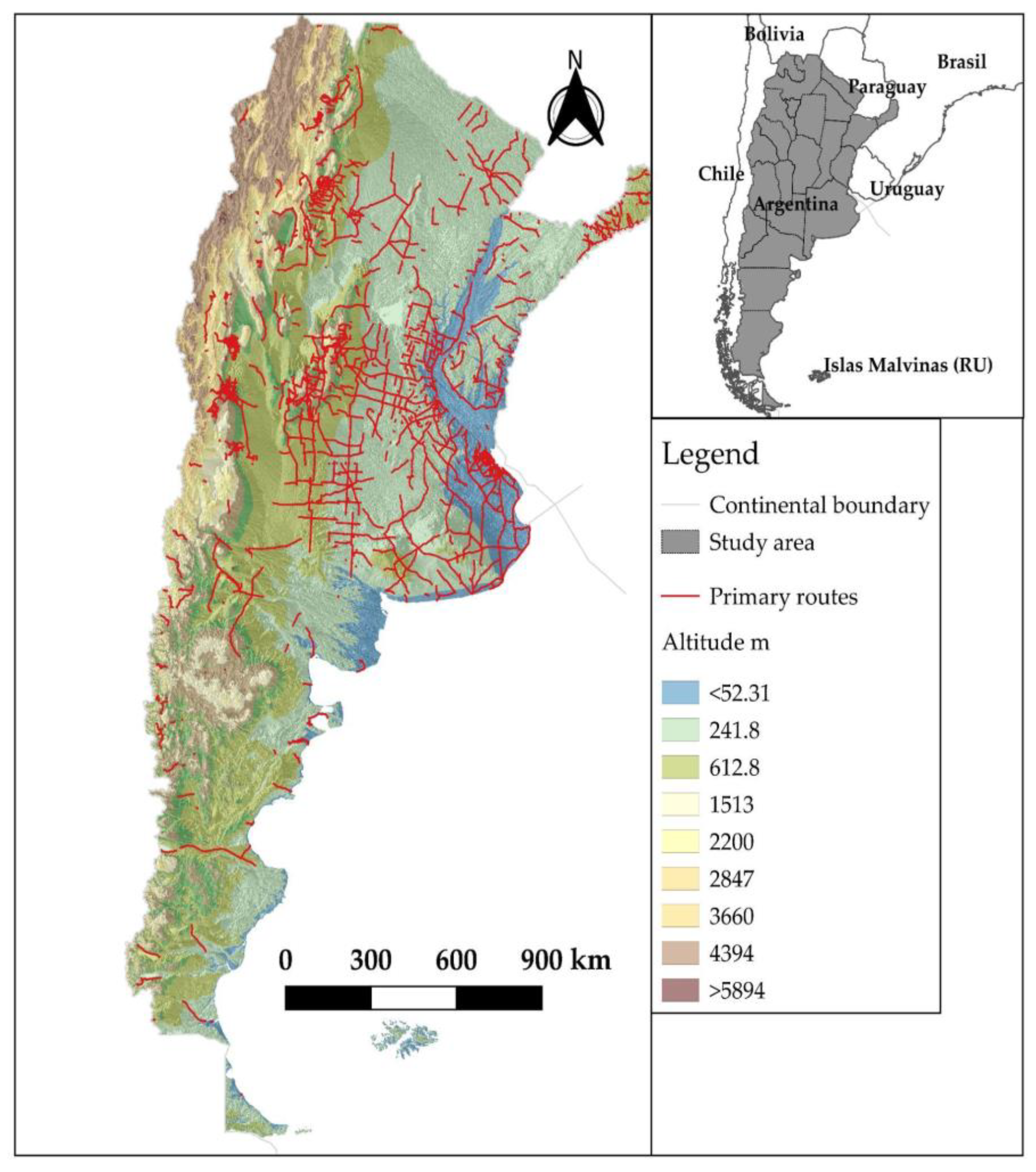
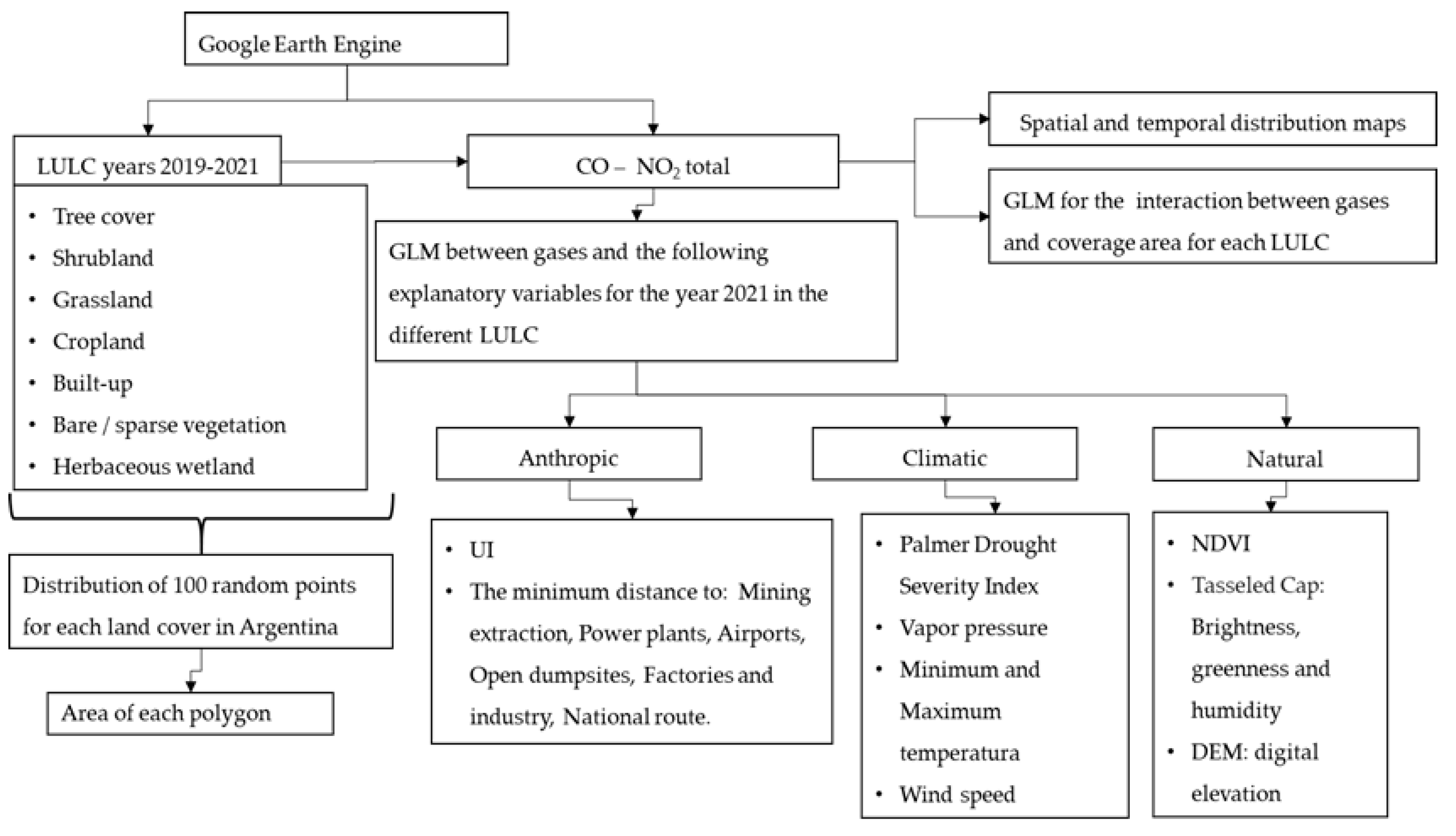
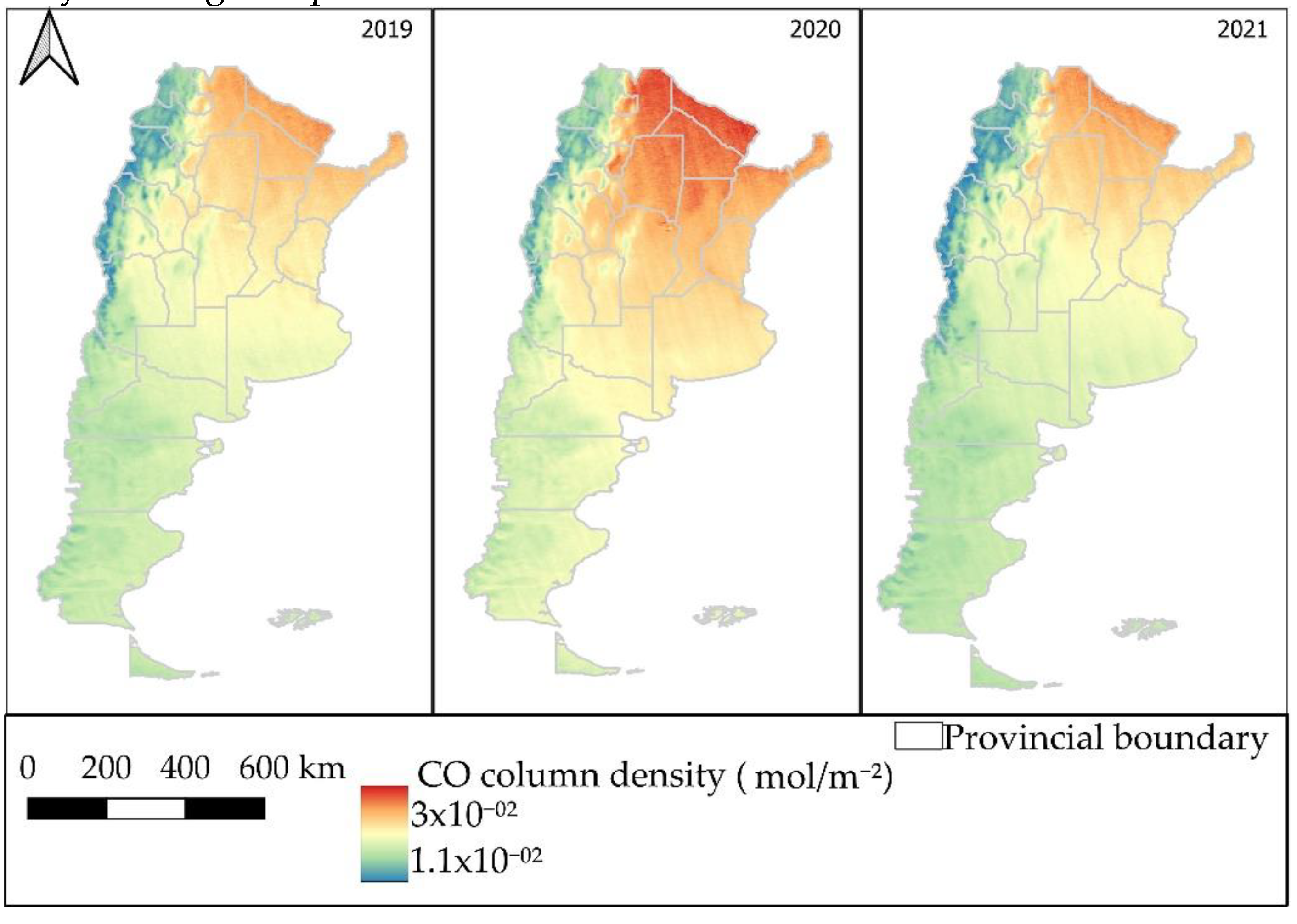
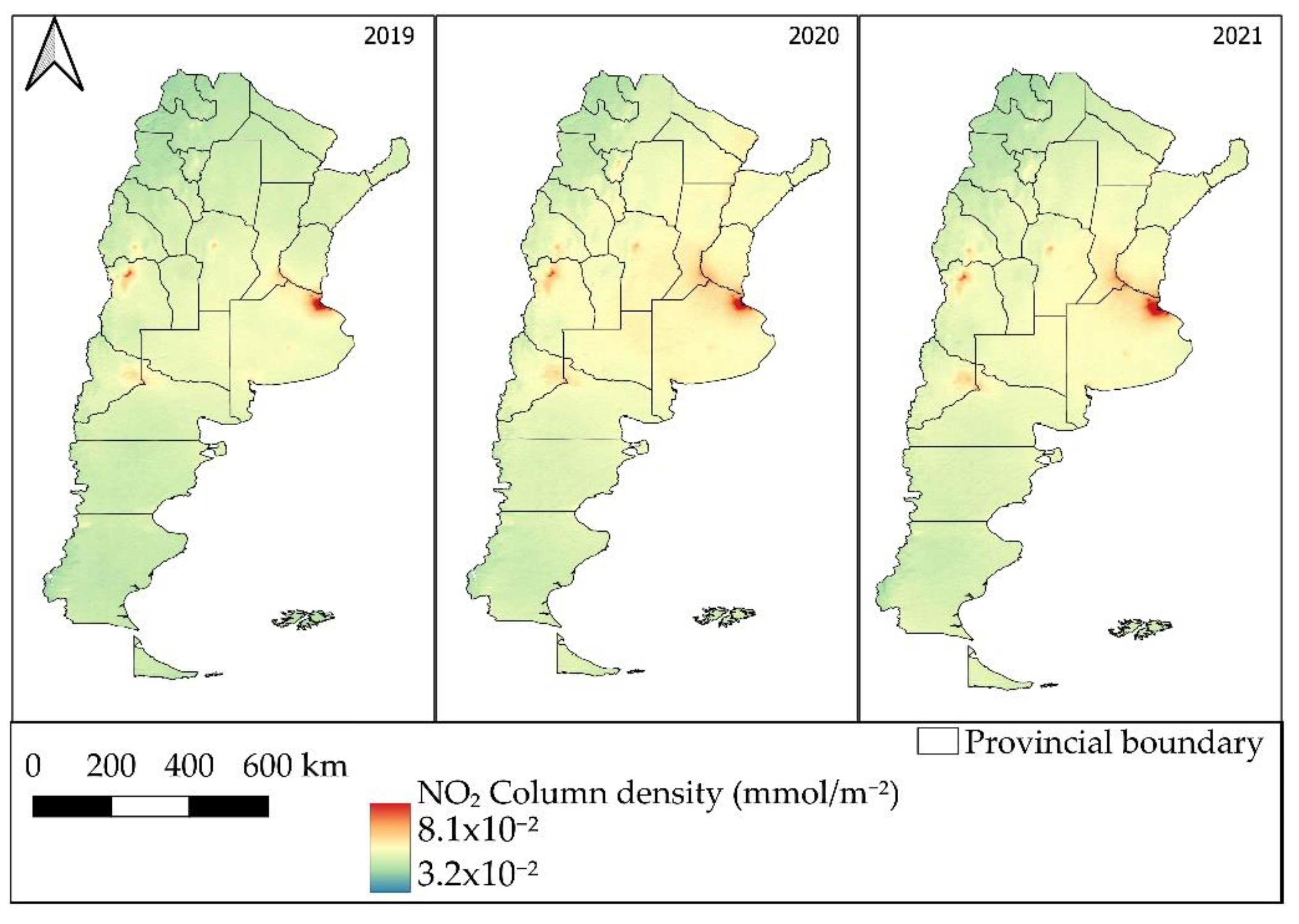
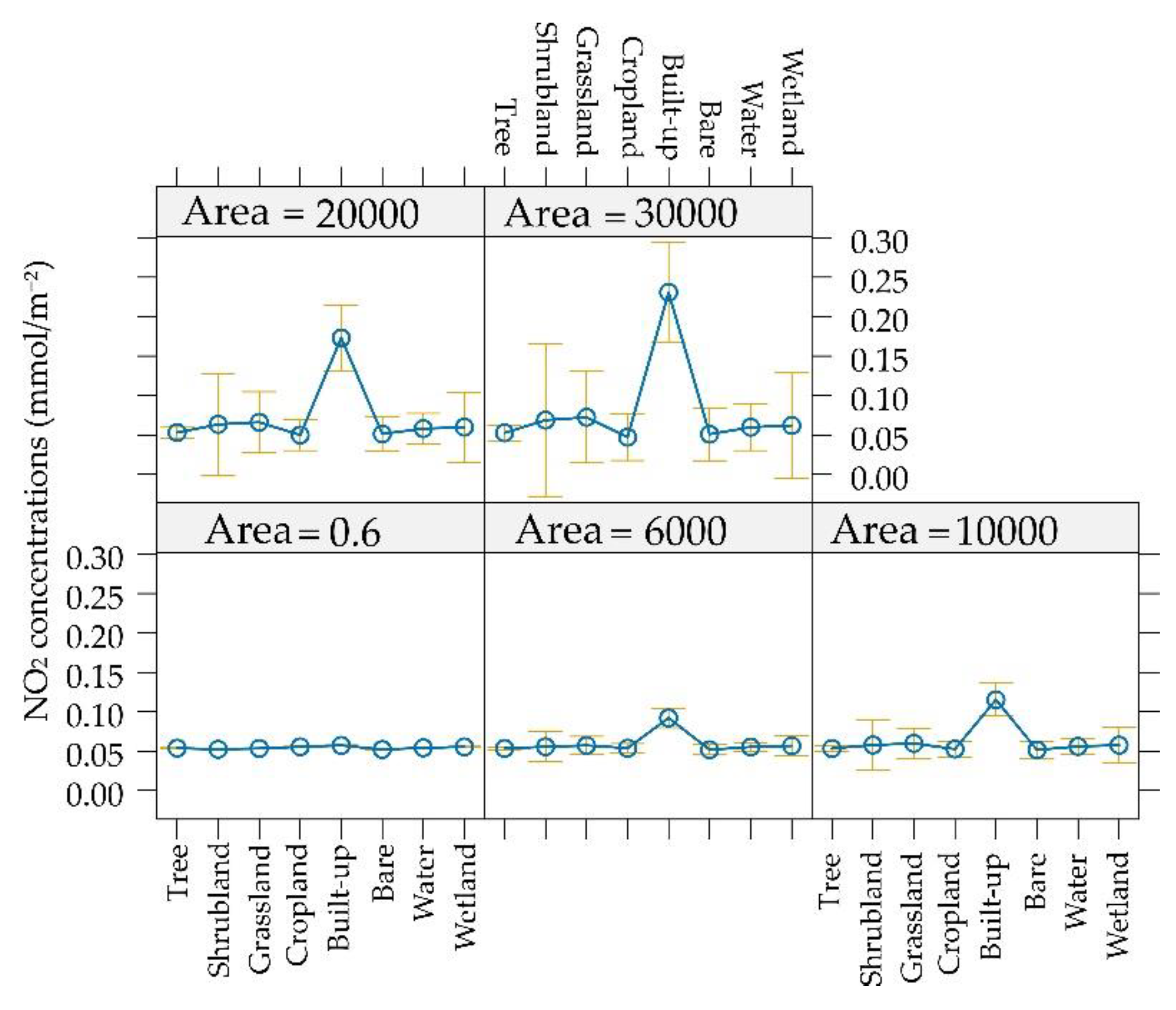
| CO | |||||
|---|---|---|---|---|---|
| Anthropic Predictors | National route | Mining extraction | Power plants | Airports | IU |
| Tree cover-Herbaceous wetland | - | - | |||
| Shrubland-Grassland | - | - | - | ||
| Cropland-Built-up | - | - | - | ||
| Bare/sparse vegetation | - | + | |||
| Climatic Predictors | Palmer Drought Index | Vapor pressure | Max environment temperature | Wind speed | |
| Tree cover-Herbaceous wetland | - | + | + | + | |
| Shrubland-Grassland | + | + | + | ||
| Cropland-Built-up | + | + | |||
| Bare/sparse vegetation | + | + | |||
| Natural Predictors | DEM | Humidity | NDVI | ||
| Tree cover-Herbaceous wetland | |||||
| Shrubland-Grassland | - | - | |||
| Cropland-Built-up | - | - | |||
| Bare/sparse vegetation | - |
| NO2 | |||||
|---|---|---|---|---|---|
| Anthropic Predictors | Service stations | Power plants | Airports | Open dumpsites | Factories-Industry |
| Tree cover-Herbaceous wetland | - | - | - | ||
| Shrubland-Grassland | - | - | |||
| Cropland-Built-up | - | - | |||
| Bare/sparse vegetation | - | ||||
| Climatic Predictors | Palmer Drought Index | Wind speed | |||
| Tree cover-Herbaceous wetland | - | - | |||
| Shrubland-Grassland | - | - | |||
| Cropland-Built-up | - | - | |||
| Bare/sparse vegetation | - | ||||
| Natural Predictors | DEM | NDVI | |||
| Tree cover-Herbaceous wetland | - | - | |||
| Shrubland-Grassland | - | ||||
| Cropland-Built-up | - | ||||
| Bare/sparse vegetation | - |
Disclaimer/Publisher’s Note: The statements, opinions and data contained in all publications are solely those of the individual author(s) and contributor(s) and not of MDPI and/or the editor(s). MDPI and/or the editor(s) disclaim responsibility for any injury to people or property resulting from any ideas, methods, instructions or products referred to in the content. |
© 2024 by the authors. Licensee MDPI, Basel, Switzerland. This article is an open access article distributed under the terms and conditions of the Creative Commons Attribution (CC BY) license (http://creativecommons.org/licenses/by/4.0/).





